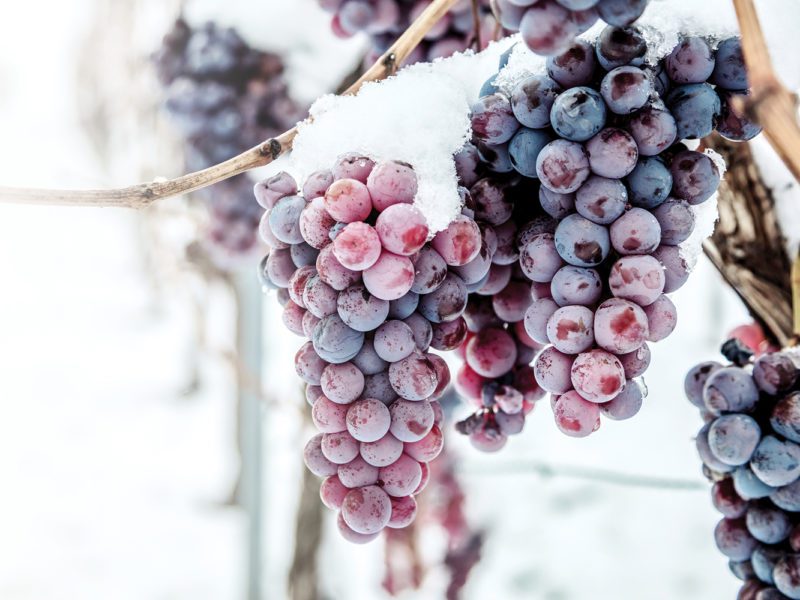
By Gary Twining
Some cool-climate winemakers – including many right here in Ohio — are eccentric searchers. They let a portion of their fruit hang on the vine until it undergoes up to 10 freezes and thaws to gain complex flavors, then they harvest the fruit while the grapes are frozen solid. These marble-like grapes are immediately pressed to extract a concentrated, precious and intensely sweet juice to make the special elixir known as ice wine.
Legend has it a 9th century German vineyard owner was called away from his winery just prior to harvest. Returning well beyond normal harvest time, he found his vineyard’s grapes all frozen on the vine. Having only the option of harvesting and attempting to make wine from his frozen fruit, he made a particularly stunning sweet wine with pleasing acidity, and ice wine was born.
Producing ice wine is particularly challenging. The fruit hangs on the vine through all the cycles of weather, long after normal harvest, and is subject to the ravages of birds and other animals who covet the sweet grapes. The grapes can fall off the cluster or succumb to various rots. Vineyard managers often wrap the vines in netting to help protect the fruit from birds and other scavengers.
The grapes must be picked and pressed while they are frozen. A temperature of 17 degrees or lower is necessary to ensure the water turns to ice and stays behind during pressing. The removal of the ice concentrates the juice and boosts the sugar content of the remaining liquid.
As little as one drop of juice comes from each pressed grape. That juice is very high in both sugar and acid, giving the wines great balance. Sugar levels at harvest vary from 32 to 46 percent. By comparison, the sugar levels in grapes harvested to make table wines generally run between 21 to 25 percent.
The grape varietals commonly utilized in ice-wine production include Riesling, Vidal Blanc, Gewürztraminer and Cabernet Franc. Grüner-Veltliner, Chenin Blanc and Merlot also can be used. All these grape varietals have firm acidity to balance the final wine’s incredibly high sugar levels.
Fermentation is a long process, due to the high sugar content in the juice. Special yeasts are used, and the conversion from juice to wine takes three to six months. The residual sugar, or amount of sugar in the finished wine, usually ranges from 18 to 32 percent, although in the winter of 2019-20, conditions in northern Ohio allowed winemakers to push the envelope a bit.
“2020 was the first time we harvested our Vidal at 51 percent sugar,” says Tony Kosicek, owner of Kosicek Vineyards. “We will release 30 gallons as a special selection that offers truly unique flavors and 36 percent residual sugar.”
Smaller bottle sizes are typical with these unctuous wines. Half-bottles (375 milliliters) are quite common, and there has been a move by some producers to release even smaller sizes, such as 200ml or even 50ml. Expect to pay a premium price due to the low-volume yields, labor-intensive production and high demand. Most 375ml bottles range from $30 to several hundred dollars, depending on origin and reputation. The most expensive ice wines are produced in Germany, although ice wine is produced in several other countries, and, of course, in Ohio.
Larry Laurello, owner of Laurello Vineyards in Geneva, says northern Ohio “produces internationally recognized, world-class ice wines. Our goal is to build a strong global market due to consumer enlightenment.”
I recently had the chance to participate in an ice wine harvest the morning of Jan. 22, 2020 at Ferrante Winery and Ristorante in Geneva. The picking was done in the dark in the still, slippery, snow-covered vine rows. The temperature was 12 degrees. It was difficult to see the fruit so that every precious berry was picked, and it also was a struggle to get the netting open to even access the grapes.
I was offered a taste of the fresh juice directly from the press, a precious reward for our efforts. The liquor was vibrant and richly sweet, with a 44 percent sugar level. The birth of the 2019 growing season’s ice wine vintage was a challenge to the Lake Erie vintners due to the lateness of the harvest, and because the cold temperatures necessary for quality ice wines did not occur until very late in the season, in some cases after the calendar flipped to 2020.
These rare-treat ice wines complement a variety of foods, so do not consider pairing them just with desserts. Try them with spicy dishes such as Thai, Creole, Mexican or Indian, or as rich preambles to foie gras and paté. Bleu and aged hard cheeses, chocolate, fruit tarts, pastries and cheesecake all are exceptional marriages with ice wine.
Here are some notes on recently tasted Grand River Valley ice wines, plus one from Vermilion:
Debonné Vineyards Vidal Ice Wine 2018, $27 (375ml): Classic fresh, floral, apricot nose. Elegant and long.
Kosicek Vineyards Vidal Ice Wine 2018, $30 (375ml): Broad texture, moderate acidity with pineapple and citrus notes.
Ferrante Winery & Ristorante Vidal Ice Wine 2017, $30 (375ml): Honeyed and complex, long and focused, with numerous evolving layers of texture.
Vermilion Valley Vineyards Chardonnay Ice Wine 2013, $50 (375ml): Aged in new French oak. Toffee and crème brûlée aromas and flavors, with rich texture.
Laurello Vineyards Cabernet Franc Ice Wine 2017, $40 (375ml): Elegant with persistent, lingering, dark fruit and blueberry notes.

